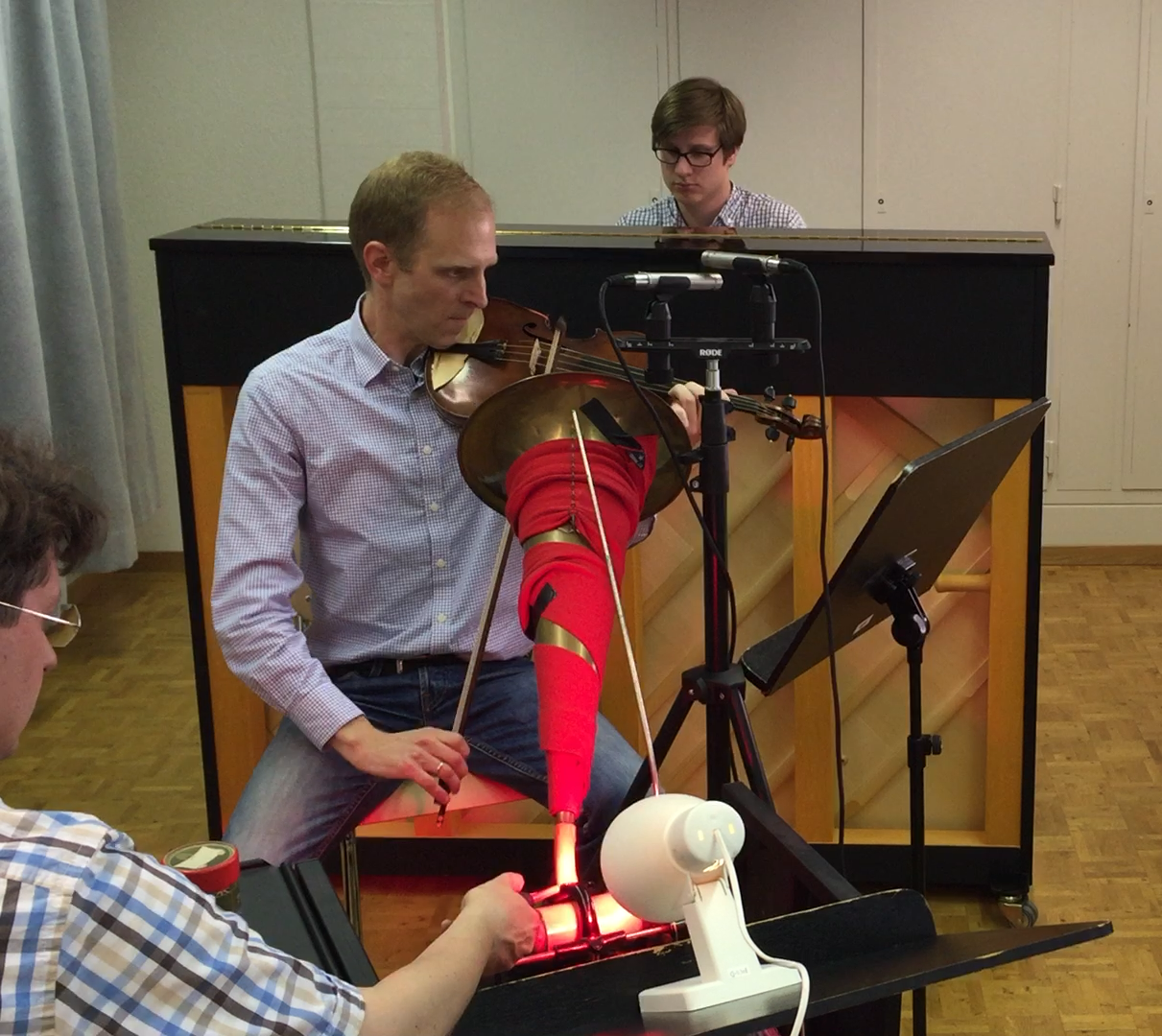Text: Thomas Gartmann | Section: On ‘Art and Science’
Abstract: Since 2011, the University of Bern and the Bern Academy of the Arts have been running a joint interdisciplinary artistic-scientific doctoral programme that is unique. This article presents the programme and its contents, but also its challenges, results, and perspectives. An in-depth interview by Angelika Boeck and Peter Tepe with Thomas Gartmann is in preparation.
Studies in the Arts: this is a relatively young branch of science. The phenomenon of researching artists, however, is not new: Leonardo da Vinci is the prime example of a universal scholar and artist, Goethe was also one, or Alexander Ritter, all of whom were interested in the natural sciences as well. However, the artistic approach to research has increased in recent years: art not only as an object, but also as a means of gaining knowledge.
But what distinguishes artistic from academic research? It is above all institutional differences and those of demarcation and division of labour: research on art. Such basic research is carried out by the university and art colleges. Research for the arts as applied research is only done by universities of applied sciences. An example of this: How do we package and transport fragile works of art? Here the Bern Academy of the Arts (HKB) did research for museums, transport, and insurance companies. Finally, we have research in and through art, or art through research, simplified: art as research. A real meta-discourse has developed on this in recent years, on definitions, quality criteria, methods, and evaluations, and above all on the justification of art as research.

Today, research in the arts is established and is also state funded in Austria and Switzerland, for example. The different characteristics of the various types of schools converged at the same time, so that the Swiss National Science Foundation, for example, soon spoke of use-inspired basic research here as well and included this perspective in the evaluation of research proposals from 2011 onwards. Consequently, in the same year, the Faculty of Humanities at the University of Bern and the HKB founded the Graduate School of the Arts (GSA), the first and for a long time the only Swiss doctoral programme for artists and designers. Since then, it has been possible in Switzerland for graduates of art, music, and theatre colleges to do a university doctorate, more exactly: a philosophical doctorate. This model, which is unique in Switzerland and beyond, offers a joint artistic/design and academic doctoral programme Studies in the Arts (SINTA, since 2019 under this name, previously as Graduate School of the Arts). These transdisciplinary SINTAs bring art and science together. Theory and practice are closely intertwined, as is basic and practice-oriented research.
When the doctoral school was founded, it was first necessary to carefully explain what research in the arts and design could actually mean and to defend it against suspicious objections. The doctoral students found themselves in a clinch of prejudices, so to speak they had to prove that they were methodically on the cutting edge and at the same time convincing artistically. Today, the programme has become indisputably self-evident: SINTA have consolidated well. The number of members has increased at just under 40, the averages duration of study at five years. Most graduates have found jobs or have been able to improve their careers; three are now second supervisors of dissertations themselves, one already holds an Ambizione position funded by the Swiss National Science Foundation, i.e., a kind of junior professorship.
So, what does this hybrid of artistic and academic doctoral programme mean, which our cooperation professes and which the programme puts on its flag and website (www.sinta.unibe.ch)? It is not the practice-based PhD that various art colleges are currently trying out. Nor is it the purely academic education that I enjoyed as a musicologist in my day. Rather, it is the Bern model, which is anchored in both institutions, with consistent dual supervision from different perspectives, with a steering committee composed of equal numbers of students, with colloquia and other events at both institutions, and with a programme that deals with the most diverse methods and theories in a transdisciplinary way, including ethnographic urban research, prototyping (in this design method, processes or products are continuously improved based on feedback from user groups) and other design methods, as well as artistic re-enactment or embodiment, in which, for example, the setting of a musical phonograph recording from 1903 is re-enacted and thus experienced anew in one’s own body. The following video shows how through the reproduction of a concrete recording situation, insights are gained into practical questions of interpretation.

Graduates later have both paths open to them, the university-academic as well as the artistic-creative, whether within the institutions, in their environment or in the wild. The versatility required for this is reflected in some of the special features of this hybrid education of an artistic-scientific doctorate. On the one hand, there are the people themselves, personalities who do not pursue linear careers but usually already bring with them a broader horizon nourished by life experience. There are other, unfamiliar, as yet untested approaches, methods and discourses, which, especially in design and interpretation research (in which both sound recordings and music editions by important interpreters, letters, notes by students, music criticism and other sources are used), must additionally search for and find their own theory formation, indeed their own language. And it is about new topics and combinations of topics that could not be dealt with at all without practical experience and artistic competence.
Currently, 39 doctoral students from the fields of music, theatre and dance studies, art history and graphic design, archaeology, social anthropology, German and Romance studies are realising their projects within the framework of SINTA. Many are former students or employees of the HKB, others came to Bern from other art colleges or universities – from St. Petersburg to Harvard.
Students from art colleges come with precise questions and topics and want to improve their academic qualifications, while graduates from universities seek practical proximity to the arts. But most of them are double talent. Some bring more artistic and creative experience with them, others more methodical knowledge and writing routine. With an art college master’s, requirements are imposed: Courses in which the specific disciplinary craft and methodological competence are taught must be attended. These requirements make up for any deficits and provide a good introduction to university practice. The SINTA provide fresh impulses for both research and the arts and open new perspectives and fields of research.
The curriculum in this structured doctoral programme includes an interdisciplinary series of workshops on topics, theories and methods in the humanities, cultural studies, and social sciences. SINTA fosters “innovative dissertation projects at the interface between art and science. The interdisciplinary and practice-based program focuses on research and reflection on artistic performance, design and aesthetic issues.”[1] A module Research in the Arts deals with the history, discourses, theories, concepts, methods, terms, paradigms and positioning of artistic research and sharpens the view of one’s own in an interdisciplinary exchange with examples, readings, a methods festival, and discussion group.
Soft-skill courses are also offered, from proposal writing to presentation techniques, from self-management to academic English. Excursions to the Swiss National Sound Archives, the Paul Sacher Foundation, the Abegg Foundation for Textile Art, the Karlsruhe Centre for Art and Media, the Vitra Campus in Weil with a visit to a Papánek exhibition or to the Paris Institut de Recherche et Coordination Acoustique/Musique (IRCAM) round off the programme.
At the beginning, as mentioned, there were the usual prejudices – from both sides. The scepticism has faded in the meantime. Today, the Bern model is recognised both nationally and internationally, and other schools even want to copy it. The more often the doctoral students were able to present their work and the broader and at the same time more distinguished the selection became, the more clearly the strengths of this successful model became apparent. In particular, the dual supervision by professors from both schools is very much appreciated. Today, applications come from all five continents, and people in Berlin and Zurich look enviously at Bern – or apply themselves. This artistic/design-scientific hybrid model has a promising future and is also appreciated by the Swiss National Science Foundation. The first doctoral projects were completed in 2016; among them a dissertation that requires design knowledge, art-historical approaches and geographical mapping techniques and thus impressively demonstrates how transdisciplinary thinking is at SINTA.
To enable doctoral students to gain even more presentation experience, the SINTA Research Day was established in 2016: Here, doctoral students present their first theses and questions or even partial results of their dissertation for 30 minutes and put them up for discussion in a second half hour, which is of course moderated by fellow students. Later, the doctoral students can expand their contributions into essays, which are also edited by their colleagues, in order to gain experience and practice in academic publishing. These are published in a series Studies in the Arts – New Perspectives on Research about, in and through Art and Design by transcript.
Website of the Doctoral program: www.sinta.unibe.ch
Illustration above the text: Cover image of Studies in the Arts (2022) with Luzia Hürzeler’s How to sleep among wolves I (2014). Picture: Luzia Hürzeler
How to cite this article
Thomas Gartmann (2022): Studies in the Arts: An Artistic-Scientific Doctorate. w/k–Between Science & Art Journal. https://doi.org/10.55597/e7614


This seems like an interesting interdisciplinary course and I’d love to know more about it. The details mentioned here were quite sufficient in order to get an overall idea. Thanks.